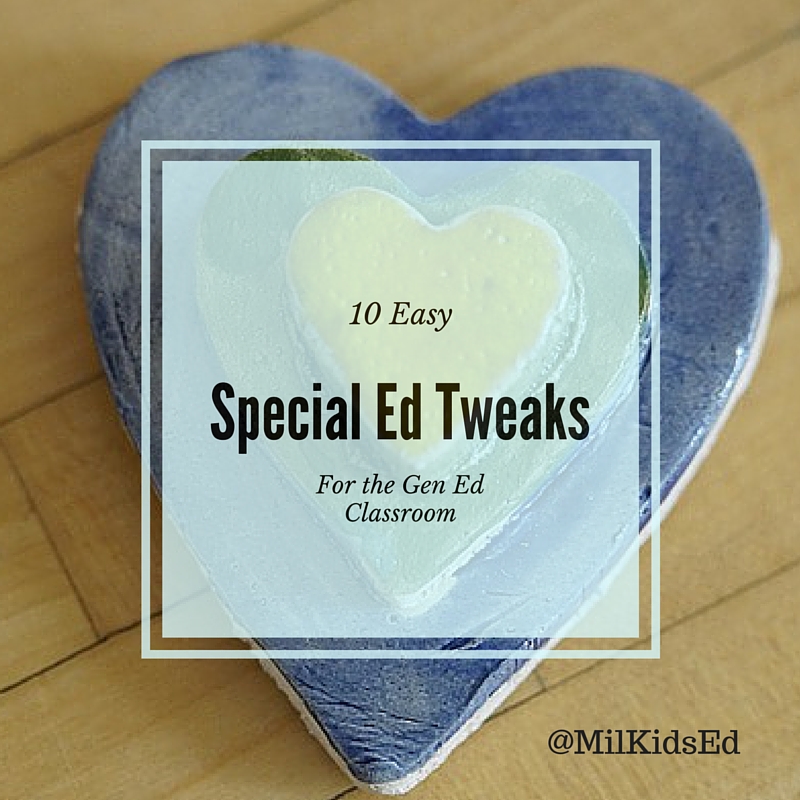
Meg Flanagan is a teacher, blogger, writer, runner, mother, and military spouse. She is passionate about helping ALL children learn, offering tips to guide parents through the K-12 education world, and providing useful advice to teachers of all ages and stages. Connect with her on Twitter at @MilKidsEdConsult.

Note: this is a version of an article originally posted on MilKids Ed. It has been edited and reposted by the original author.
If your classrooms are like mine, your students span the spectrum of abilities and learning styles.
My kids fidget at their desks, can’t sit still for any length of time, and have varying timelines for mastering new content.
Instead of fighting it, I’m embracing it. I’m just using special education tricks and tips to work with my students’ learning styles.
Here are my 10 best special education tips for the general education classroom.
1. Walk Away from the Desks: Have you ever sat in those chairs? They are deeply uncomfortable. And we are asking children to spend the majority of their days sitting “appropriately” in them. Which is why I stopped. I instituted freedom of learning. My kids are allowed to work anywhere they want during dedicated independent or group time as long as they follow two rules: 1) you may not disturb anyone else; 2) you must be actively engaged in learning. I’ve had students working under desks, sprawled on the floor, or sitting on my long sturdy bookshelves beside the windows. The work product I’ve gotten is superior to the “sit in the chair” assignments.
2. Bounce it Out: Two words: Exercise balls. They let kids bounce safely and release that extra tension or get out the wiggles or just move a little bit. And they are relatively inexpensive. While I don’t have them in my classroom, my co-teacher used them. When she used them, the kids behaved better, listened more attentively, and worked more consistently. Not to say they were perfect angels, but it was better. Maybe put them on your next teacher wish list?
 3. Become Yogis: Stretching and yoga is seriously underrated in the classroom. I use it because it helps children decompress, stretches their bodies, and quiets their minds. I have used yoga to teach children of all abilities. Even just once a week, or before tests, helps children to feel calmer and more secure. We instituted a regular before testing yoga session, and last year 90% of my students passed ALL their standardized testing.
3. Become Yogis: Stretching and yoga is seriously underrated in the classroom. I use it because it helps children decompress, stretches their bodies, and quiets their minds. I have used yoga to teach children of all abilities. Even just once a week, or before tests, helps children to feel calmer and more secure. We instituted a regular before testing yoga session, and last year 90% of my students passed ALL their standardized testing.
4. Sensory Strips: Some kids need a little bit of sensory stimulation to calm down or focus. Find out if this is something that your student might need, then find out what kind of textures appeal to them. I use 3M adhesive strips or sticky velcro strips on the non-dominant inside of their desk to attach their textures. Then the student can use their sensory strips without anyone else being the wiser.
5. Fidgets: Some kids need a little something to do with their hands. So instead of tapping on the desk or spinning rulers, I bought paracord and bead fidgets made by someone from my hometown. The beads slid around on the paracord and the students got to move a little bit without distracting anyone.
6. Movement Breaks: When everything else fails, sometimes a nice walk does the trick. Currently, we know them as “brain breaks,” a trendy term for what special education teachers have been doing for years. In my class, we dance, we play Simon Says, we are silly. Because kids need a break from the monotony of teaching and learning. After a break, I have noticed that they focus better.
7. Take a Walk:Of course, no all children need to move in the same way. For a lot of kids, I create my own menu of movement breaks. They get to pick a walk or movement to fit their mood or needs at the time. Sometimes a few quick loops on the stairs, other times an errand to the main office. When the whole class is losing it, we go for a quick walk outside.
 8. Work Reminders: Some students need a little extra nudge, and a work reminder can do just that for them. Many of my kiddos use timers to help them stay on track. For other kids I created I work progress charts that let’s them know what they need to do each day. I even incentivize it, with rewards for work completion and optimal work habits.
8. Work Reminders: Some students need a little extra nudge, and a work reminder can do just that for them. Many of my kiddos use timers to help them stay on track. For other kids I created I work progress charts that let’s them know what they need to do each day. I even incentivize it, with rewards for work completion and optimal work habits.
9. Modify It: Let’s just be brutally honest: not all kids work at grade level. Some will never work at their age appropriate grade level, and some will be way above grade level. So what do you do? You modify. For reading materials, find something of similar content that is on their grade level. For activities or assessments, try to create or find similar work at their level. Ask: What is the essential thing that I want students to walk away from this with? Then target that.
10. Get Creative: Look at your resources: art supplies, technology, whatever. And use them. Assessments don’t need to be done the traditional way; reports don’t need to be written or typed. Why not use videos to teach or review concepts? Why not let your students demonstrate their knowledge through artwork or poetry or something else. Get out of the box and work there.
How do you use special education tips and tricks in your general education classroom?
Meg Flanagan is a teacher, education blogger, and special education advocate. Meg holds an M.Ed in Special Education, a BS in Elementary Education, and is licensed in both areas in three states. She created, writes, and edits MilKids Ed, a blog focused on military children, their parents, and their teachers. Meg is on Twitter @MilKidsEd, Pinterest, and Facebook. If you would like to work with Meg, either in a consulting capacity or as a guest writer, please contact her here.
Reblogged this on Blustery Thoughts.
LikeLiked by 1 person
I can definitely see how those figits could be useful, but in my first grade class, when I’ve offered tension balls or other small hand manipulatives, other kids seem to always try to grab them, and they end up creating a distraction. How do you handle this?
LikeLike
Great question! Right from the start we talk about needs and fair (getting what you need, not the same things). When I use the figits, I repeat that same idea about fairness. I remind everyone to keep hands to themselves, too. For first graders, you could try using spots: everyone has a special place to sit, you must stay completely in your space.
LikeLike